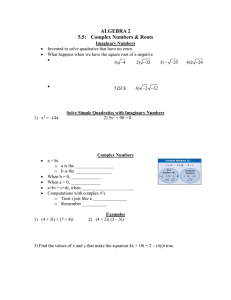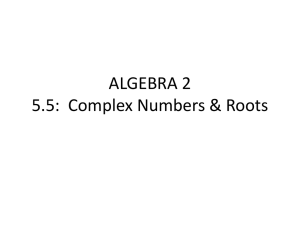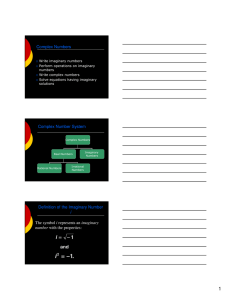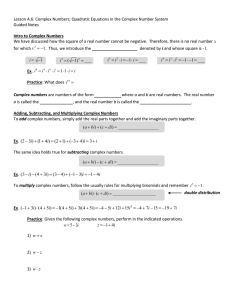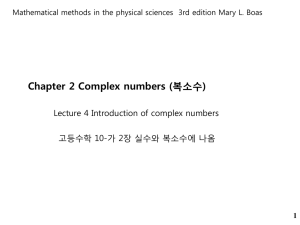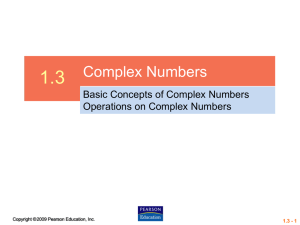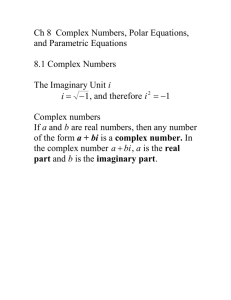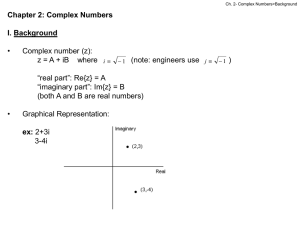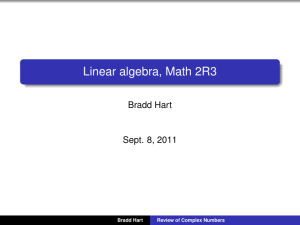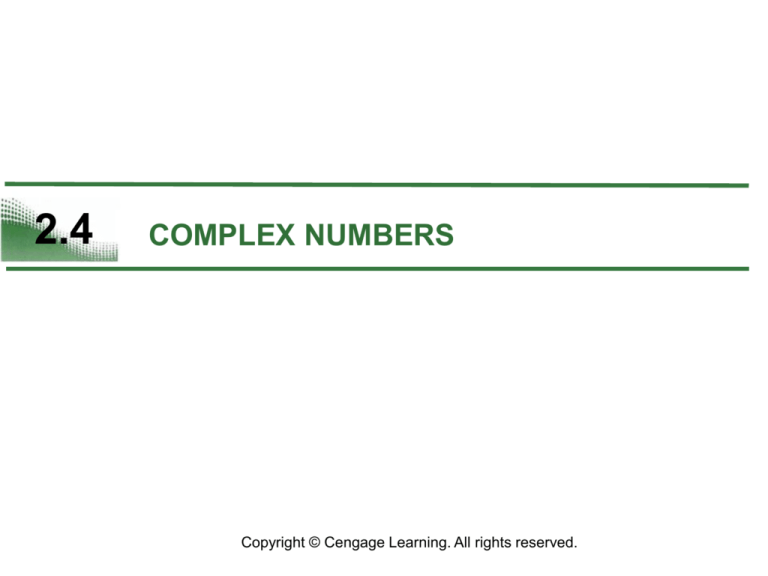
2.4
COMPLEX NUMBERS
Copyright © Cengage Learning. All rights reserved.
What You Should Learn
• Use the imaginary unit i to write complex
numbers.
• Add, subtract, and multiply complex numbers.
• Use complex conjugates to write the quotient of
two complex numbers in standard form.
• Find complex solutions of quadratic equations.
2
The Imaginary Unit i
3
The Imaginary Unit i
𝑥 2 + 1 = 0 has no real solution
has complex solution
Imaginary unit 𝒊
𝑖 = −1
where 𝑖 2 = −1
4
The Imaginary Unit i
Complex number in standard form:
𝒂 + 𝒃𝒊
Example:
Complex number −5 + −9
Standard form:
−5 + 3𝑖
5
The Imaginary Unit i
𝒂
Real part
+
𝒃𝒊
imaginary part
6
The Imaginary Unit i
𝑎 = 𝑎 + 0𝑖
7
The Imaginary Unit i
EXAMPLE:
𝑥 + 4𝑖 = −2 + 𝑏𝑖
⇒
𝑥 = −2
4=𝑏
8
Operations with Complex Numbers
9
Operations with Complex Numbers
EXAMPLE:
Add/Subtract binomials
2 + 5𝑖 − (4 + 7𝑖)
2 + 5𝑥 − (4 + 7𝑥)
= 2−4 + 5−7 𝑖
= 2−4 + 5−7 𝑥
= −2 + −2 𝑖
= −2 + −2 𝑥
= −2 − 2𝑖
= −2 − 2𝑥
10
Operations with Complex Numbers
The additive identity in the complex number system is
zero (the same as in the real number system).
The additive inverse of the complex number a + bi is
–(a + bi) = –a – bi.
Additive inverse
(a + bi) + (–a – bi) = 0 + 0i = 0.
11
Example 1 – Adding and Subtracting Complex Numbers
a. (4 + 7i) + (1 – 6i) = 4 + 7i + 1 – 6i
Remove parentheses.
= (4 + 1) + (7i – 6i)
Group like terms.
=5+i
Write in standard form.
b. (1 + 2i) – (4 + 2i) = 1 + 2i – 4 – 2i
Remove parentheses.
= (1 – 4) + (2i – 2i)
Group like terms.
= –3 + 0
Simplify.
= –3
Write in standard form.
12
Example 1 – Adding and Subtracting Complex Numbers
cont’d
c. 3i – (–2 + 3i) – (2 + 5i) = 3i + 2 – 3i – 2 – 5i
= (2 – 2) + (3i – 3i – 5i)
= 0 – 5i
= –5i
d. (3 + 2i) + (4 – i) – (7 + i) = 3 + 2i + 4 – i – 7 – i
= (3 + 4 – 7) + (2i – i – i)
= 0 + 0i
=0
13
Operations with Complex Numbers
(a + bi)(c + di) = a(c + di) + bi(c + di)
= ac + (ad)i + (bc)i + (bd)i2
= ac + (ad)i + (bc)i + (bd)(–1)
Distributive Property
Distributive Property
i 2 = –1
= ac – bd + (ad)i + (bc)i
Commutative Property
= (ac – bd) + (ad + bc)i
Associative Property
14
FOIL
Complex Numbers
Binomials
15
Complex Conjugates
16
Complex Conjugates
The product of two complex numbers can be a real
number.
This occurs with pairs of complex numbers of the form
a + bi and a – bi, called complex conjugates.
(a + bi)(a – bi) = a2 – abi + abi – b2i2
= a2 – b2(–1)
= a2 + b2
17
Example 3 – Multiplying Conjugates
Multiply each complex number by its complex conjugate.
a. 1 + i
b. 4 – 3i
Solution:
a. The complex conjugate of 1 + i is 1 – i.
(1 + i )(1 – i) = 12 – i2
= 1 – (–1)
=2
18
Example 3 – Solution
cont’d
b. The complex conjugate of 4 – 3i is 4 + 3i.
(4 – 3i)(4 + 3i) = 42 – (3i)2
= 16 – 9i2
= 16 – 9(–1)
= 25
19
Complex Conjugates
To write the quotient of a + bi and c + di in standard form,
where c and d are not both zero, multiply the numerator
and denominator by the complex conjugate of the
denominator to obtain
Standard form
20
Complex Solutions of Quadratic
Equations
21
Complex Solutions of Quadratic Equations
When using the Quadratic Formula to solve a quadratic
equation, you often obtain a result such as
, which you
know is not a real number. By factoring out i =
, you
can write this number in standard form.
The number
i is called the principal square root of –3.
22
Example 6 – Complex Solutions of a Quadratic Equation
Solve (a) x2 + 4 = 0 and (b) 3x2 – 2x + 5 = 0.
Solution:
a. x2 + 4 = 0
x2 = –4
x = 2i
b. 3x2 – 2x + 5 = 0
Write original equation.
Subtract 4 from each side.
Extract square roots.
Write original equation.
Quadratic Formula
23
Example 6 – Solution
cont’d
Simplify.
Write
in standard form.
Write in standard form.
24

